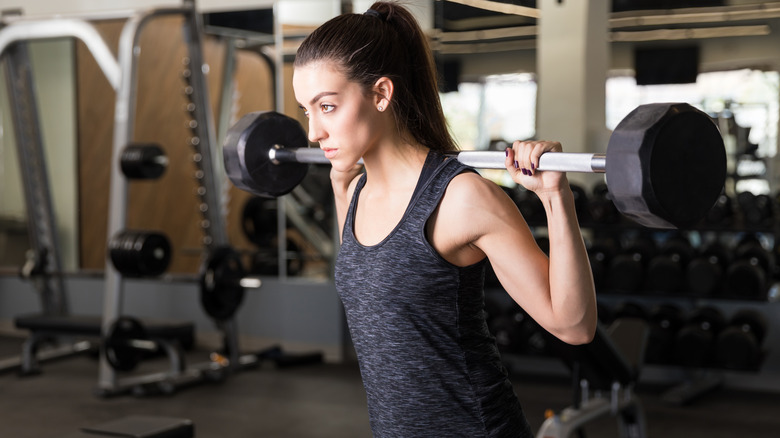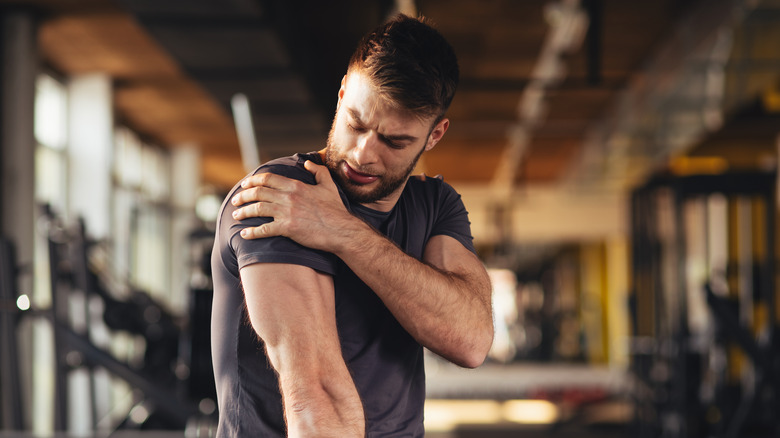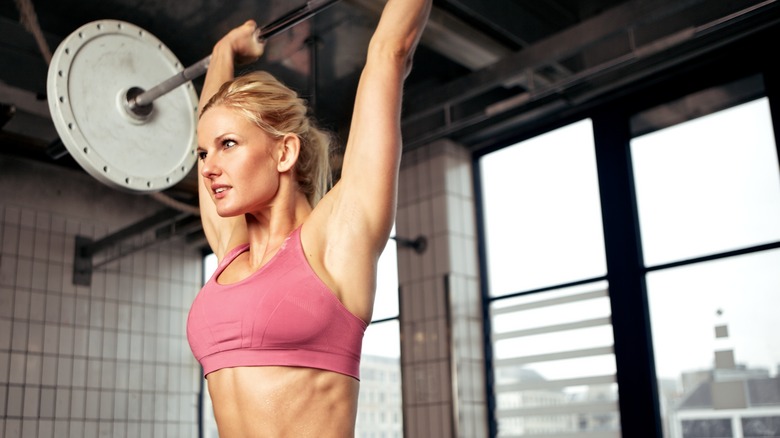Why Behind-The-Neck Presses Are So Controversial
Behind-the-neck presses have a bad rap for causing injuries despite being one of the most popular strength exercises out there. When done properly, this movement targets the front shoulders along with other muscles, such as the triceps and lateral deltoids. It also engages the upper, middle, and lower traps, explains ExRx. Since it hits multiple muscles, it's considered a compound exercise.
Contrary to popular belief, this classic bodybuilding move is safe when executed correctly. Canadian strength training coach Christian Thibaudeau told T-Nation that behind-the-neck presses don't normally cause shoulder issues. However, they may aggravate existing problems in gym-goers with poor shoulder mobility or kyphosis, a disorder that causes the spine to curve outward. Thibaudeau also says that behind-the-neck presses are excellent for overall shoulder development, offering better results than barbell military presses.
So, why is this compound movement so controversial? After all, it has been a staple in the bodybuilding world for decades. Thibaudeau notes that professional bodybuilder Reg Park, American former professional wrestler Ted Arcidi, Russian former Olympic weightlifter Dmitry Klokov, and other top athletes performed behind-the-neck presses with hundreds of pounds. While this exercise is generally safe, it can still lead to injuries under certain circumstances. That's why it's essential to use proper form and increase the load gradually as you progress.
Behind-the-neck presses: good or bad?
Bodybuilding legend Ronnie Coleman says that behind-the-neck presses are neither safe nor effective (via Muscle and Fitness). This multi-joint exercise takes some of the pressure off your shoulders but increases the stress on your lats, traps, and other upper back muscles. Since you're using your back muscles to pull the weight up, you may feel stronger and lift heavier. While this movement can boost overall strength, it's not challenging enough to give you a good shoulder workout, explains Coleman.
He also warns that behind-the-neck presses place your rotator cuffs in an awkward position, which may lead to injuries. There is also a risk of hurting your neck, notes Healthline. The risk of injury is even higher in those with poor mobility in the shoulder or upper spine. Apart from that, this movement is no more dangerous than other strength exercises.
"I don't see Olympic lifters complaining about shoulder pain. If you don't have the mobility to do the press behind the neck, then don't. But it's not the boogieman people make it out to be," said professional bodybuilder and powerlifter Paul Carter in an interview with Muscle and Fitness. "Plenty of people blow out their shoulders from the standard bench press, but I don't see anyone shying away from benching every Monday," he added. Coleman, on the other hand, recommends the military press as a safer, more effective alternative to behind-the-neck presses.
How to perform behind-the-neck presses with proper form
It takes just one wrong move to injure your back or shoulders when lifting a loaded barbell overhead. Maintaining proper form will not only reduce injury risk but also lead to better results. The behind-the-neck press can be performed from a standing or seated position. Both versions use the same movement pattern, but the seated variation is safer overall.
To get started, place a barbell in the rack just below your shoulder height when you're standing. Sit on an upright bench and grab the bar with your palms facing away from your body. Take a deep breath, squeeze your core, then slowly lower the barbell behind your neck (Muscle and Strength). Exhale while pressing the bar up, and then return to the starting position. Muscle and Strength recommends using a wider grip if you're feeling pain in your shoulders. Avoid rolling your wrists or leaning back more than necessary.
If you have mobility issues and cannot perform behind-the-neck presses, look for safer alternatives. Pro bodybuilder Ronnie Coleman praises the military press, saying that it allows you to isolate your delts and build shoulder strength (via Muscle and Fitness). You may also try isolation exercises, such as front or lateral dumbbell raises. Another option is to perform the behind-the-neck press with dumbbells so you have better control over the movement.



